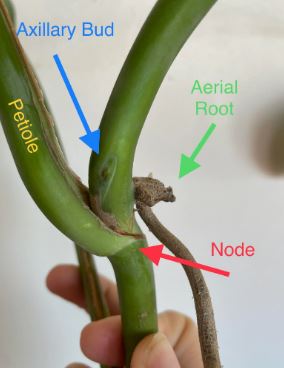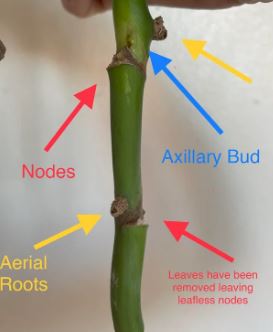Monstera nodes are growth points on the plant’s stem, crucial for new development. Aerial roots, growing above ground, provide stability and support but don’t propagate new plants. Trim them for aesthetics. Monstera propagation involves cutting stems below nodes. Aerial roots enhance nutrient absorption and support. Reddit offers valuable insights into Monstera care.
Monstera plants, with their unique foliage and distinct growth patterns, often raise questions about nodes and aerial roots. Let’s delve into the intriguing comparison between Monstera nodes and aerial roots to unravel their roles in the plant’s development.
Monstera Node vs Aerial Root: Understanding the Basics
1. What is a Monstera Node and Aerial Root?
A Monstera node is a crucial part of the plant’s anatomy where essential cells for growth reside. On the other hand, an aerial root is exactly what it sounds like—a root that grows above the ground level, providing support and nutrients. Nodes form directly on the stem, while aerial roots typically grow out of the stem near nodes but can sometimes emerge directly from nodes.
Monstera aerial roots exhibit a fascinating feature, shooting upwards and growing above ground level, showcasing a superb characteristic that sets this plant apart from many others.
As an Amazon Associate we earn from qualifying purchases.
Table of Contents
2. Can Monstera Grow from Aerial Roots?
No, Monstera cannot grow directly from aerial roots. Aerial roots have no propagation function and will not give rise to new Monstera plants if placed in water. For propagation, it’s essential to cut a healthy Monstera stem/leaf below a node.
While the aerial roots contribute to the plant’s stability and nutrient absorption, they don’t serve as a means for creating new Monstera plants.
3. Monstera Node vs Aerial Root Reddit Insights
For more in-depth insights into the Monstera node vs aerial root debate, the Reddit community offers valuable discussions. Users share experiences and knowledge about propagating Monstera, addressing questions about the role of nodes and aerial roots in the plant’s growth.
Reddit serves as a rich source of community-driven information, offering diverse perspectives and practical tips on Monstera care.

Monstera Aerial Roots: To Cut or Not to Cut?
1. Is it Okay to Cut Off Monstera Aerial Roots?
Yes, it is perfectly acceptable to trim Monstera aerial roots if you prefer a sleek appearance for your plant. Mature plants can develop thick aerial roots that may extend several feet. To maintain a tidy look, trimming these roots close to the stem is advisable. Ensure to use sterilized, sharp shears to prevent the risk of disease spread.
Trimming Monstera aerial roots is a cosmetic choice that doesn’t harm the plant. Regular pruning helps maintain the desired appearance and prevents overgrowth.
2. Do Aerial Roots Come from Nodes?
Yes, aerial roots are typically found growing near nodes. Understanding the relationship between nodes and aerial roots is essential for successful propagation. Plant nodes play a vital role in the development of new growth, making propagation with aerial roots more straightforward compared to other methods.
The proximity of aerial roots to nodes makes them integral to the plant’s natural propagation process, contributing to the overall health and vitality of the Monstera.
3. Can You Bury Monstera Aerial Roots?
Burying Monstera aerial roots is not necessary, as these roots are adapted to grow above the ground. They serve the purpose of providing support, absorbing nutrients, and enhancing the plant’s stability. Attempting to bury aerial roots may interfere with the plant’s natural growth pattern and could potentially lead to issues.
Burying Monstera aerial roots goes against their natural growth habit. Allowing them to grow freely contributes to the plant’s overall well-being.

Monstera Node Cutting: A Step-by-Step Guide
1. How to Identify a Node on a Monstera?
A node on a Monstera plant is a critical point where new growth, such as leaves, stems, and buds, originates. Nodes are slightly raised or swollen areas along the stem, often where a leaf is or was attached. Identifying nodes is crucial for various plant-related activities, including propagation.
Nodes serve as the epicenter of growth on a Monstera plant, facilitating the emergence of leaves, stems, and other vital components.
2. Monstera Node Cutting Process
To propagate a Monstera using a node cutting, follow these step-by-step instructions:
- Identify a Healthy Node with Axillary Bud: Locate a node with an axillary bud, typically found on the stem.
- Precision Cutting Below the Node: Using sharp, clean pruning shears, make a precise cut 1 to 2 inches below the identified node along the internode.
- Moisten the Rooting Medium: Prepare a suitable rooting medium and moisten it adequately.
- Insert the Cutting: Make a hole in the rooting medium and carefully insert the Monstera cutting, ensuring it is stable.
- Maintain Moisture: Keep the cuttings consistently moist, providing a conducive environment for root development.
Following these steps ensures a successful Monstera node cutting, allowing you to propagate new plants with precision and care.
Moss Poles and Monstera: Enhancing Growth
1. When Should I Add a Moss Pole to My Monstera?
Introducing a moss pole to your Monstera is beneficial when you observe the plant displaying a desire for upward growth. If your Monstera starts leaning or growing sideways, adding a moss pole provides the necessary support for vertical development.
The introduction of a moss pole serves as a strategic measure to guide your Monstera’s growth upwards, preventing it from sprawling and enhancing its aesthetic appeal.
2. Why Is My Monstera Growing Sideways?
Monstera plants may exhibit sideways growth for various reasons, including insufficient light, lack of support, or natural growth habits. If your Monstera is sprawling excessively, introducing a moss pole can help redirect its growth vertically, promoting a healthier and more appealing appearance.
Understanding the factors contributing to sideways growth enables you to address them effectively, ensuring your Monstera thrives in an optimal environment.
Aerial Roots in Water: Debunking Myths
1. Are Aerial Roots Good for Monstera?
Yes, aerial roots play a crucial role in the well-being of a Monstera plant. These roots provide additional stability, support, and contribute to nutrient absorption. While they may look unconventional, especially when protruding above the soil, aerial roots are a natural and beneficial feature of the Monstera.
Aerial roots contribute to the overall health of a Monstera plant, enhancing its ability to thrive and adapt to its environment.
2. How Often Should You Water Your Monstera?
The frequency of watering your Monstera depends on various factors, including the environmental conditions, potting mix, and the size of the pot. As a general guideline, allow the top inch of the soil to dry out before watering. Adjust your watering routine based on the specific needs of your plant and the prevailing conditions in its environment.
Understanding the moisture requirements of your Monstera is key to maintaining a healthy balance, preventing overwatering or underwatering.
3. Addressing Yellowing Leaves on Monstera
Yellowing leaves on a Monstera can be a sign of overwatering, underwatering, nutrient deficiencies, or pest issues. Assess the soil moisture, adjust your watering routine, and consider applying a balanced fertilizer. Additionally, inspect the plant for pests and take appropriate measures to address any infestations.
Yellowing leaves are a common concern and can be addressed by identifying and rectifying the underlying issues affecting your Monstera’s health.
Monstera Care and Troubleshooting
1. How to Maintain Aesthetic Appeal with Brown Aerial Roots?
While brown aerial roots are a natural part of a Monstera’s growth, they can be pruned for aesthetic reasons. Use clean, sharp shears to trim brown aerial roots close to the stem. Ensure proper sterilization to prevent the spread of diseases. Regular pruning of brown aerial roots helps maintain the visual appeal of your Monstera.
Managing brown aerial roots through regular pruning ensures your Monstera retains its visual allure, promoting a tidy and well-groomed appearance.
2. Repotting Guidelines and Aerial Roots Management
When repotting your Monstera, carefully examine the roots and trim any unhealthy or overgrown sections. While aerial roots are generally left intact, you can trim them if they hinder the repotting process. Ensure the new pot provides ample space for root expansion, promoting continued growth and development.
Repotting is a crucial aspect of Monstera care, and proper management of aerial roots contributes to the overall health and vitality of the plant.
The Significance of Aerial Roots in Monstera
1. What Functions Do Aerial Roots Serve in Monstera Survival?
Aerial roots in Monstera plants serve multiple functions critical to their survival. These roots provide structural support, anchor the plant to surrounding surfaces, and absorb nutrients from the air. Additionally, aerial roots contribute to the overall adaptability of the Monstera, allowing it to thrive in various environments.
The multifaceted roles of aerial roots contribute significantly to the resilience and adaptability of Monstera plants, ensuring their survival in diverse conditions.
2. How Do Aerial Roots Provide Support and Nutrients?
Aerial roots play a pivotal role in providing support to the Monstera plant. As the roots grow and attach to surrounding surfaces, they enhance the stability of the plant. Moreover, these roots have the capability to absorb nutrients directly from the air, supplementing the plant’s nutritional needs.
The dual role of aerial roots in providing both physical support and nutrient absorption underscores their importance in maintaining the well-being of a Monstera plant.
Rooting Monstera Without Aerial Roots: Exploring Alternatives
1. What Are Alternative Propagation Methods for Monstera?
If your Monstera lacks prominent aerial roots, alternative propagation methods can be employed. Stem cuttings with nodes are a popular choice. Follow the same propagation steps as with nodes containing aerial roots, ensuring the cuttings have sufficient nodes for successful root development.
In the absence of prominent aerial roots, alternative propagation methods using stem cuttings with nodes can be effectively utilized to expand your Monstera collection.
2. Ensuring Successful Root Development in Monstera Propagation
To ensure successful root development in Monstera propagation, focus on providing optimal conditions. Maintain consistent moisture, provide indirect light, and avoid overwatering. Utilize a well-draining rooting medium to encourage the development of a healthy root system.
Creating an environment conducive to root development is paramount for successful Monstera propagation, ensuring the establishment of robust and healthy new plants.
Conclusion
In conclusion, understanding the distinctions between Monstera nodes and aerial roots is essential for effective care and propagation. Whether you’re propagating through node cuttings or addressing the unique characteristics of aerial roots, a comprehensive approach ensures the health and vitality of your Monstera plant. Incorporating community insights and debunking myths contribute to a holistic understanding of Monstera growth, fostering a rewarding and aesthetically pleasing plant-care experience.
Table: Key Subtopics in Monstera Node vs Aerial Root Comparison
| Subtopic | Description |
|---|---|
| Monstera Node and Aerial Root Definitions | Explaining the basic characteristics and roles of nodes and aerial roots. |
| Location on the Stem | Discussing where nodes and aerial roots are positioned on the Monstera stem. |
| Can Monstera Grow from Aerial Roots? | Examining the reality of Monstera propagation from aerial roots. |
| Monstera Node Cutting | A step-by-step guide to cutting and propagating Monstera nodes. |
| Monstera Aerial Roots Propagation | Exploring methods and considerations for propagating Monstera through aerial roots. |
| Aerial Roots and Nodes Relationship | Investigating the interconnected growth between aerial roots and nodes. |
| Pruning and Maintenance | Addressing common concerns related to pruning and maintaining Monstera plants. |
| Common Questions and Concerns | Providing insights into frequently asked questions about Monstera growth. |
| The Importance of Aerial Roots | Delving into the functions and significance of aerial roots in Monstera plants. |
| Monstera Care and Troubleshooting | Offering guidance on caring for Monstera plants and troubleshooting common issues. |
| Rooting Monstera Without Aerial Roots | Exploring alternative propagation methods when aerial roots are not prominent. |
| Conclusion | Summarizing key points and emphasizing the holistic approach to Monstera care. |
© 2024 Lotusmagus.com. All rights reserved. This content is protected by copyright. Visit Lotusmagus.com for more information.

